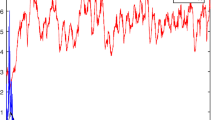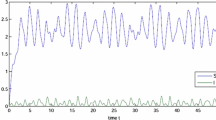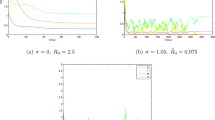Abstract
This paper formulates two stochastic nonautonomous SIRI epidemic systems with nonlinear perturbations. The main aim of this study is to investigate stochastic dynamics of the two SIRI epidemic systems and obtain their thresholds. For the nonautonomous stochastic SIRI epidemic system with white noise, the authors provide analytic results regarding the stochastic boundedness, stochastic permanence and persistence in mean. Moreover, the authors prove that the system has at least one nontrivial positive T-periodic solution by using Lyapunov function and Hasminskii’s theory. For the system with Markov conversion, the authors establish sufficient conditions for positive recurrence and existence of ergodic stationary distribution. In addition, sufficient conditions for the extinction of disease are obtained. Finally, numerical simulations are introduced to illustrate the main results.
Similar content being viewed by others
References
Anderson R, May R, and Medley G, A preliminary study of the transmission dynamics of the human immunodeficiency virus (HIV), the causative agent of AIDS, IMA J. Math. Appl. Med., 1986, 3: 229–263.
Herbert H W, The mathematics of infectious diseases, SIAM Rev., 2000, 42: 599–653.
Brauer F and Chavez C C, Mathematical Models in Population Biology and Epidemiology, Springer, New York, 2001.
Gao S J, Chen L S, Nieto J J, et al., Analysis of a delayed epidemic model with pulse vaccination and saturation incidence, Vaccine, 2006, 24: 6037–6045.
Li X Z, Li W S, and Ghosh M, Stability and bifurcation of an SIS epidemic model with treatment, Chaos. Solitons Fractals, 2009, 42: 2822–2832.
Ma Z E, Zhou Y C, and Wu J H, Modeling and Dynamics of Infectious Diseases, Higher Education Press, Beijing, 2009.
Meng X Z, Stability of a novel stochastic epidemic model with double epidemic hypothesis, Appl. Math. Comput., 2010, 217: 506–515.
Liu X B and Yang L J, Stability analysis of an SEIQV epidemic model with saturated incidence rate, Nonlinear Anal. Real World Appl., 2012, 13: 2671–2679.
Wang W and Ma W B, A diffusive HIV infection model with nonlocal delayed transmission, Appl. Math. Lett., 2018, 75: 96–101.
Korobeinikov A, Lyaounov functions and global stability for SIR and SIRS epidemiological models with nonlinear transmission, Bull. Math. Biol., 2006, 30: 615–636.
Ji C, Jiang D Q, and Shi N Z, Multigroup SIR epidemic model with stochastic perturbation, Phys. A, 2011, 390: 1747–1762.
Gray A, Greenhalgh D, Hu L, et al., A stochastic differential equation SIS epidemic model, SIAM J. Appl. Math., 2011, 71: 876–902.
Zhang T Q, Meng X Z, Zhang T H, et al., Global dynamics for a new high-dimensional sir model with distributed delay, Appl. Math. Comput., 2012, 218: 11806–11819.
Chen Q L, Teng Z D, Wang L, et al., The existence of codimension-two bifurcation in a discrete SIS epidemic model with standard incidence, Nonlinear Dynam., 2013, 71: 55–73.
Wang J L, Muroya Y, and Kuniya T Y, Global stability of a time-delayed multi-group SIS epidemic model with nonlinear incidence rates and patch structure, J. Math. Anal. Appl., 2015, 425: 415–439.
Liu Q and Jiang D Q, The threshold of a stochastic delayed SIR epidemic model with vaccination, Phys. A, 2016, 461: 140–147.
Meng X Z, Zhao S N, Feng T, et al., Dynamics of a novel nonlinear atochastic SIS epidemic model with double epidemic hypothesis, J. Math. Anal. Appl., 2016, 433: 227–242.
Liu G D, Wang X H, Meng X Z, et al., Extinction and persistence in mean of a novel delay impulsive stochastic infected predator-prey system with jumps, Complexity, 2017, 2017(3): 1–15.
Miao A Q, Zhang J, Zhang T Q, et al., Threshold dynamics of a stochastic SIR model with vertical transmission and vaccination. Comput. Math. Method. M., 2017, 2017, DOI: https://doi.org/10.1155/2017/4820183.
Miao A Q, Wang X Y, Wang W, et al., Dynamical analysis of a stochastic SIS epidemic model with nonlinear incidence rate and double epidemic hypothesis, Adv. Difference Equ., 2017, 2017: 226.
Tudor D, A deterministic model for herpes infections in human and animal polulations, SIAM Rev., 1990, 32: 130–139.
Ding S S and Wang F J, SILI epidemiological model with nonlinear incidence rates, J. Biomath., 1994, 9: 1–59.
Blower S, Modeling the genital herpes epidemic, Herpes, 2004, 11(Suppl.3): 138–146.
Wang J L and Shu H Y, Global analysis on a class of multi-group SEIR model with latency and relapse, Math. Biosci. Eng., 2016, 13: 200–225.
Fatini M E, Lahrouz A, Pettersson R, et al., Stochastic stability and instability of an epidemic model with relapse, Appl. Math. Comput., 2018, 316: 326–341.
Liu Q, Jiang D Q, Hayat T, et al., Stationary distribution and extinction of a stochastic SIRI epidemic model with relapse, Stoch. Anal. Appl., 2018, 36: 138–151.
Has’miniskii R, Stochastic Stability of Differential Equations, Sijthoff Noordhoff, Alphen aan den Rijn, 1980.
Mao X R, Stochastic Differential Equations and Their Applications, Horwood Publishing, Chichester, 1997.
Roberts M G and Saha A K, The asymptotic behaviour of a logistic epidemic model with stochastic disease transmission, Appl. Math. Lett., 1999, 12: 37–41.
Du N H and Sam V H, Dynamics of a stochastic Lotka-Volterra model perturbed by white noise, J. Math. Anal. Appl., 2006, 324: 82–97.
Zhao Y N, Jiang D Q, and O’Regan D, The extinction and persistence of the stochastic SIS epidemic model with vaccination, Phys. A, 2013, 392: 4916–4927.
Ma H J and Jia Y M, Stability analysis for stochastic differential equations with infinite markovian switchings, J. Math. Anal. Appl., 2016, 435: 593–605.
Meng X Z and Zhang L, Evolutionary dynamics in a Lotka-Volterra competition model with impulsive periodic disturbance, Math. Methods Appl. Sci., 2016, 39: 177–188.
Meng X Z, Wang L, and Zhang T H, Global dynamics analysis of a nonlinear impulsive stochastic chemostat system in a polluted environment, J. Appl. Anal. Comput., 2016, 6: 865–875.
Liu Q, Jiang D Q, Shi N Z, et al., Stationary distribution and extinction of a stochastic SEIR epidemic model with standard incidence, Phys. A, 2017, 476: 58–69.
Liu L D and Meng X Z, Optimal harvesting control and dynamics of two-species stochastic model with delays, Adv. Difference Equ., 2017, 2017: 18, https://doi.org/10.1186/s13662-017-1077-6.
Zhang S Q, Meng X Z, and Zhang T H, Dynamics analysis and numerical simulations of a stochastic non-autonomous predator-prey system with impulsive effects, Nonlinear Anal. Hybrid Syst., 2017, 26: 19–37.
Jódar L, Villanueva R J, and Arenas A, Modeling the spread of seasonal epidemical diseases: Theory and applications, Math. Comput. Model., 2008, 48: 548–557.
Lin Y G, Jiang D Q, and Liu T H, Nontrivial periodic solution of a stochastic epidemic model with seasonal variation, Appl. Math. Lett., 2015, 45: 103–107.
Zhu C and Yin G, Asymptotic properties of hybrid diffusion system, SIAM J. Control. Optim., 2007, 46: 1155–1179.
Kutoyants A Y, Statistical Inference for Ergodic Diffusion Processes, Springer, London, 2003.
Author information
Authors and Affiliations
Corresponding author
Additional information
This work is supported by the National Natural Science Foundation of China under Grant No. 11371230, the Research Fund for the Taishan Scholar Project of Shandong Province of China, and the SDUST Research Fund under Grant No. 2014TDJH102.
Rights and permissions
About this article
Cite this article
Zhang, W., Meng, X. & Dong, Y. Periodic Solution and Ergodic Stationary Distribution of Stochastic SIRI Epidemic Systems with Nonlinear Perturbations. J Syst Sci Complex 32, 1104–1124 (2019). https://doi.org/10.1007/s11424-018-7348-9
Received:
Revised:
Published:
Issue Date:
DOI: https://doi.org/10.1007/s11424-018-7348-9




